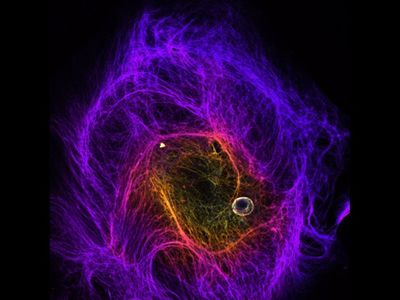- The basic layout of the light microscope as consisting of a microscope objective and an eye-piece, and their properties such as aberrations, magnification, numerical aperture, and field of view.
- Different methods for obaining contrast in a microscope, such as absorption, fluorescence, and phase-contrast methods.
- Different image-quality measures such as resolution, contrast, signal-to-noise ratio (SNR), modulation transfer function (MTF), sampling density, field of view, and depth of field.
- Layout of the illumination systems, particularly Köhler illumination for transmission and epi-fluorescence microscopy, and how the illumination system can be used to optimize image quality.
- How properties of the microscope and illumination system affect image quality such as resolution and contrast, mainly via Fourier methods including point-spread functions (PSF) and optical transfer functions (OTF, MTF).
- How the choice of detector affects image quality measures such as signal-to-noise (SNR) and sampling. How to sample to avoid loss of information and artefacts. Some microscope photometry.
- The basic layout for confocal microscopy and hence three-dimensional imaging, including resolution and sampling in different dimensions.
- The basics of nanoscopy and imaging beyond the classical resolution limit.
SK2501 Physics of Biomedical Microscopy, Extended Course 7.5 credits

This course is an extended version of SK2500 which includes a seminar on modern microscopy methods and applications recently published.
Information per course offering
Information for Autumn 2024 Start 28 Oct 2024 programme students
- Course location
AlbaNova
- Duration
- 28 Oct 2024 - 13 Jan 2025
- Periods
- P2 (7.5 hp)
- Pace of study
50%
- Application code
50188
- Form of study
Normal Daytime
- Language of instruction
English
- Course memo
- Number of places
Places are not limited
- Target group
For all programs as long as it can be included in your programme.
- Planned modular schedule
- [object Object]
- Schedule
Contact
Anna Burvall (anna.burvall@biox.kth.se),
Course syllabus as PDF
Please note: all information from the Course syllabus is available on this page in an accessible format.
Course syllabus SK2501 (Autumn 2023–)Content and learning outcomes
Course contents
Intended learning outcomes
After completing the course the student should be able to:
- adjust the microscope and the illumination system to obtain optimal performance in transmission and fluorescence microscopy.
- select suitable contrast methods and microscope objectives for standard microscopic samples.
- perform and report quantitative microscopic measurements, including image computer processing and 3D visualization.
- extract and comprehensively present relevant information from a scientific publication.
- assess how different image quality measures are affected by physical limits connected to choices of microscopes and imaging parameters, and use this knowledge to choose suitable settings in new imaging experiments.
Literature and preparations
Specific prerequisites
English B / English 6
Recommended prerequisites
Basic knowledge of waves, geometrical optics and photometry (course SK1100 or similar). Elementary knowledge of the Fourier transform.
Equipment
Literature
Examination and completion
If the course is discontinued, students may request to be examined during the following two academic years.
Grading scale
Examination
- LAB1 - Laboratory Experiments, 2.0 credits, grading scale: P, F
- SEM1 - Seminar, 1.5 credits, grading scale: P, F
- TEN1 - Examination, 4.0 credits, grading scale: A, B, C, D, E, FX, F
Based on recommendation from KTH’s coordinator for disabilities, the examiner will decide how to adapt an examination for students with documented disability.
The examiner may apply another examination format when re-examining individual students.
Other requirements for final grade
The course is examined through a combination of oral and written examination (TEN1; 4 credits, grading scale A/B/C/D/E/Fx/F), as well as approved labs (LAB1; 2 credits, grading scale P/F), and a seminar presentation (SEM1; 1.5 credits, grading scale P/F). The grade for TEN1 determines the grade for the course.
Opportunity to complete the requirements via supplementary examination
Opportunity to raise an approved grade via renewed examination
Yes
Examiner
Ethical approach
- All members of a group are responsible for the group's work.
- In any assessment, every student shall honestly disclose any help received and sources used.
- In an oral assessment, every student shall be able to present and answer questions about the entire assignment and solution.